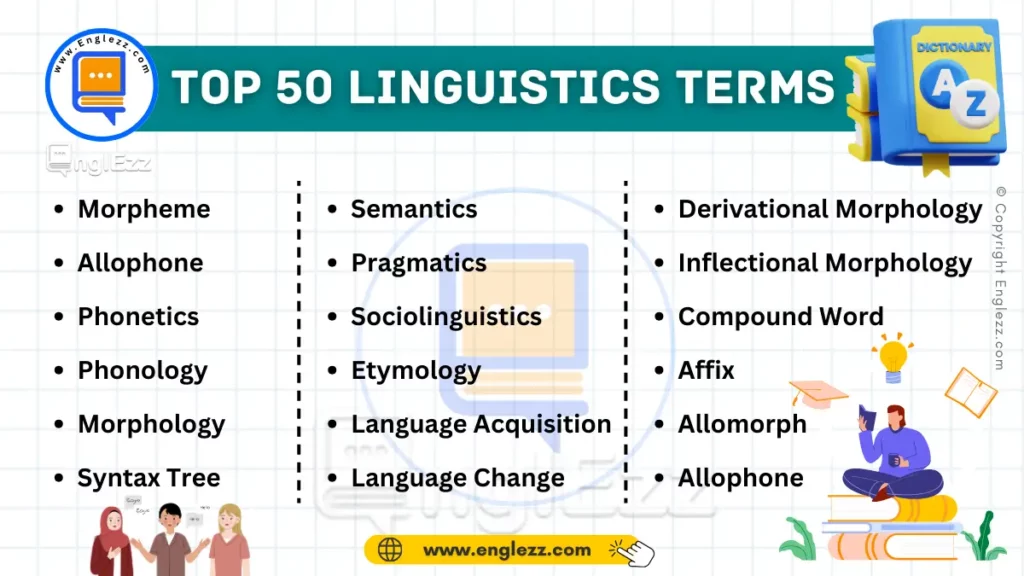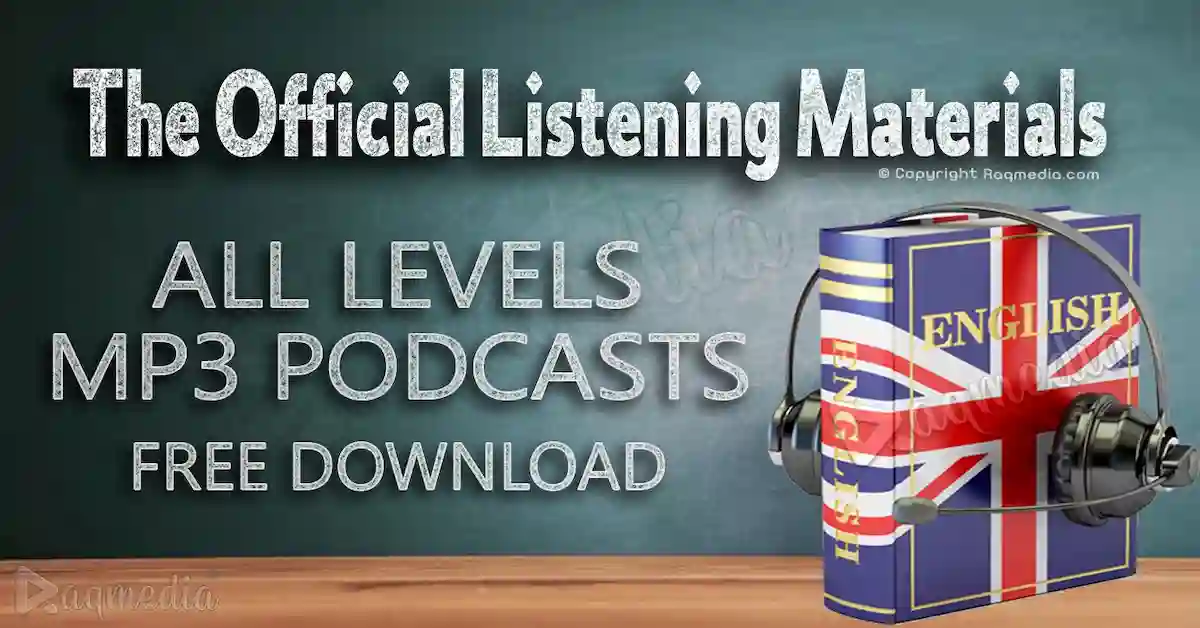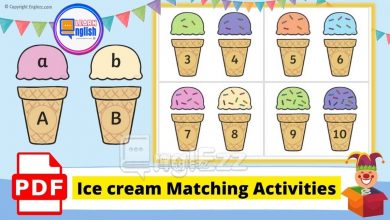Linguistics, the scientific study of language, is a fascinating field that explores the intricacies of human communication. For students delving into this area, a strong grasp of key terminology is essential. Understanding these terms not only deepens comprehension but also enhances the ability to engage with complex texts and participate in scholarly discussions. This guide provides an overview of 50 must-know lnguistics terms for students, complete with definitions, phonetic transcriptions, and practical examples.
Table of Contents
- 50 Essential Linguistics Terms Every Student Must Know
- #1. 📜 Phonetics (fəˈnɛtɪks)
- #2. 🗣️ Phonology (fəˈnɒlədʒi)
- #3. 📚 Morphology (mɔːrˈfɒlədʒi)
- #4. 🧩 Syntax (ˈsɪntæks)
- #5. 🌍 Semantics (sɪˈmæntɪks)
- #6. 🧠 Pragmatics (præɡˈmætɪks)
- #7. 🔤 Lexicography (ˌlɛksɪˈkɒɡrəfi)
- #8. 🧬 Sociolinguistics (ˌsoʊsiəʊlɪŋˈɡwɪstɪks)
- #9. 🌐 Dialectology (ˌdaɪəˌlɛkˈtɒlədʒi)
- #10. 📏 Descriptive Grammar (dɪˈskrɪptɪv ˈɡræmər)
- #11. 📐 Prescriptive Grammar (prɪˈskrɪptɪv ˈɡræmər)
- #12. 📊 Corpus Linguistics (ˈkɔːrpəs lɪŋˈɡwɪstɪks)
- #13. 📖 Etymology (ˌɛtɪˈmɒlədʒi)
- #14. 📝 Syntax Tree (ˈsɪntæks triː)
- #15. 🗺️ Language Family (ˈlæŋɡwɪdʒ ˈfæmɪli)
- #16. 🧭 Language Acquisition (ˈlæŋɡwɪdʒ əˌkwɪˈzɪʃən)
- #17. 🔍 Minimal Pair (ˈmɪnɪməl pɛər)
- #18. 🔤 International Phonetic Alphabet (IPA) (ˌɪntərˈnæʃənəl fəˈnɛtɪk ˈælfəˌbɛt)
- #19. 📐 Morpheme (ˈmɔːrfiːm)
- #20. 🌐 Code-Switching (koʊd ˈswɪtʃɪŋ)
- #21. 🔄 Reduplication (rɪˌduːplɪˈkeɪʃən)
- #22. 📜 Derivational Morphology (ˌdɛrɪˈveɪʃənəl mɔːrˈfɒlədʒi)
- #23. 📈 Inflectional Morphology (ɪnˈflɛkʃənəl mɔːrˈfɒlədʒi)
- #24. 📦 Compound Word (ˈkɒmpaʊnd wɜːrd)
- #25. 🔠 Affix (ˈæfɪks)
- #26. 📜 Allomorph (ˈæləmɔːrf)
- #27. 📑 Allophone (ˈælɪfoʊn)
- #28. 🔬 Articulatory Phonetics (ɑːˈtɪkjʊlətɔːri fəˈnɛtɪks)
- #29. 📚 Computational Linguistics (ˌkɒmpjʊˈteɪʃənəl lɪŋˈɡwɪstɪks)
- #30. 📈 Language Typology (ˈlæŋɡwɪdʒ tɪˈpɒlədʒi)
- #31. 🔍 Psycholinguistics (ˌsaɪkoʊlɪŋˈɡwɪstɪks)
- #32. 🧠 Neurolinguistics (ˌnʊərəʊlɪŋˈɡwɪstɪks)
- #33. 🌟 Sociophonetics (ˌsoʊsɪoʊfəˈnɛtɪks)
- #34. 📝 Orthography (ɔːrˈθɒɡrəfi)
- #35. 🗨️ Pragmatic Markers (prægˈmætɪk ˈmɑːrkərz)
- #36. 🔡 Grapheme (ˈɡræfiːm)
- #37. 📜 Prosody (ˈprɒsədi)
- #38. 🔤 Transliteration (ˌtrænzˌlɪtəˈreɪʃən)
- #39. 📚 Linguistic Relativity (lɪŋˈɡwɪstɪk rɪˈlætɪvɪti)
- #40. 🕵️ Interlanguage (ˈɪntərˌlæŋɡwɪdʒ)
- #41. 🧩 Pragmatic Competence (prægˈmætɪk ˈkɒmpɪtəns)
- #42. 🔍 Phonotactics (ˌfəʊnəʊˈtæktɪks)
- #43. 🌍 Language Contact (ˈlæŋɡwɪdʒ ˈkɒntækt)
- #44. 🧬 Genetic Linguistics (ˌʤɛnɪtɪk lɪŋˈɡwɪstɪks)
- #45. 📊 Sociolinguistic Variables (ˌsoʊsiəʊlɪŋˈɡwɪstɪk ˈvɛəriəbəlz)
- #46. 🧠 Cognitive Linguistics (ˈkɒɡnɪtɪv lɪŋˈɡwɪstɪks)
- #47. 🔠 Morphosyntax (ˌmɔːrfəˈsɪntæks)
- #48. 📋 Dialect Continuum (ˈdaɪəlɛkt kənˈtɪnjuəm)
- #49. 🌍 Endangered Language (ɪnˈdeɪndʒərd ˈlæŋɡwɪdʒ)
- #50. 🔍 Language Ideology (ˈlæŋɡwɪdʒ aɪˈdiːələdʒi)
- Vocabulary List for Linguistics Students
- Wrapping Up:
50 Essential Linguistics Terms Every Student Must Know
Whether you’re a beginner in linguistics or looking to refresh your knowledge, mastering these terms will empower you to explore the depths of language structures, sounds, meanings, and cultural influences. Dive in to expand your linguistic repertoire and enhance your academic journey.
Remember, language is more than just words; it’s the foundation of human interaction and society. So, let’s embark on this linguistic journey and uncover the essential vocabulary that every linguistics student should know!
#1. 📜 Phonetics (fəˈnɛtɪks)
Definition: The study of the physical sounds of human speech.
Examples:
- Phonetics analyzes how different sounds are produced by the vocal cords.
- Understanding phonetics helps in mastering accents and pronunciations.
#2. 🗣️ Phonology (fəˈnɒlədʒi)
Definition: The study of how sounds function within a particular language or languages.
Examples:
- Phonology examines the rules that govern sound patterns in languages.
- In English phonology, the ‘p’ sound in “pat” differs from the ‘p’ in “spat.”

#3. 📚 Morphology (mɔːrˈfɒlədʒi)
Definition: The study of the structure and form of words in a language, including morphemes.
Examples:
- Morphology looks at how words are formed from smaller units like roots and affixes.
- The word “unhappiness” consists of three morphemes: “un-“, “happy”, and “-ness.”
#4. 🧩 Syntax (ˈsɪntæks)
Definition: The study of sentence structure and the rules that govern the formation of sentences.
Examples:
- Syntax explains why “I see the cat” is correct but “See I the cat” is not.
- English syntax typically follows a subject-verb-object order.
#5. 🌍 Semantics (sɪˈmæntɪks)
Definition: The study of meaning in language, including word meanings and sentence meanings.
Examples:
- Semantics explores how the meaning of “bank” changes in different contexts (e.g., riverbank vs. financial bank).
- Understanding semantics is crucial for interpreting ambiguous phrases.
#6. 🧠 Pragmatics (præɡˈmætɪks)
Definition: The study of how context influences the interpretation of meaning in communication.
Examples:
- Pragmatics helps explain why “Can you pass the salt?” is understood as a request, not a question.
- The field investigates how politeness and indirect language affect conversations.
#7. 🔤 Lexicography (ˌlɛksɪˈkɒɡrəfi)
Definition: The art and science of dictionary-making.
Examples:
- Lexicography involves compiling words and their meanings into dictionaries.
- A lexicographer might decide which new words are included in an updated edition.
#8. 🧬 Sociolinguistics (ˌsoʊsiəʊlɪŋˈɡwɪstɪks)
Definition: The study of how language varies and changes in social groups and contexts.
Examples:
- Sociolinguistics examines why different regions have distinct accents and dialects.
- This field explores how factors like age, gender, and socioeconomic status affect language use.
#9. 🌐 Dialectology (ˌdaɪəˌlɛkˈtɒlədʒi)
Definition: The study of regional and social variations in language.
Examples:
- Dialectology maps out the differences in vocabulary and grammar between British and American English.
- It investigates why speakers from different parts of a country use distinct expressions.
#10. 📏 Descriptive Grammar (dɪˈskrɪptɪv ˈɡræmər)
Definition: An approach to grammar that describes how language is actually used, rather than prescribing rules.
Examples:
- Descriptive grammar notes that people often end sentences with prepositions, despite traditional rules.
- It focuses on real-world language use rather than what is considered “proper.”
#11. 📐 Prescriptive Grammar (prɪˈskrɪptɪv ˈɡræmər)
Definition: An approach to grammar that sets rules for how language should be used.
Examples:
- Prescriptive grammar insists on not splitting infinitives (e.g., “to boldly go” should be “to go boldly”).
- It often aligns with formal writing and educational standards.
#12. 📊 Corpus Linguistics (ˈkɔːrpəs lɪŋˈɡwɪstɪks)
Definition: The study of language as expressed in corpora (bodies of text) and analyzed using computational tools.
Examples:
- Corpus linguistics helps linguists understand language trends over time by analyzing large text collections.
- This method is used to study word frequency and collocations in different genres.
#13. 📖 Etymology (ˌɛtɪˈmɒlədʒi)
Definition: The study of the origin and history of words.
Examples:
- Etymology traces how the word “salary” comes from the Latin “salarium,” which refers to money given to Roman soldiers to buy salt.
- Knowing etymology helps understand the evolution of word meanings over centuries.
#14. 📝 Syntax Tree (ˈsɪntæks triː)
Definition: A visual representation of the syntactic structure of a sentence.
Examples:
- Syntax trees illustrate the hierarchical relationships between words and phrases in a sentence.
- Linguists use syntax trees to analyze complex sentence structures.
#15. 🗺️ Language Family (ˈlæŋɡwɪdʒ ˈfæmɪli)
Definition: A group of related languages that have a common ancestral language.
Examples:
- The Romance languages (e.g., Spanish, French, Italian) are part of the Indo-European language family.
- Language families help linguists understand how languages evolve and influence each other.
#16. 🧭 Language Acquisition (ˈlæŋɡwɪdʒ əˌkwɪˈzɪʃən)
Definition: The process by which humans learn language, typically during childhood.
Examples:
- Language acquisition involves the stages from babbling to fluent speech in children.
- Research in this area explores how second languages are learned differently from native languages.
#17. 🔍 Minimal Pair (ˈmɪnɪməl pɛər)
Definition: A pair of words that differ by only one phoneme, used to demonstrate the phonemic contrasts in a language.
Examples:
- The words “bat” and “pat” are a minimal pair in English, differing only in the initial consonant.
- Minimal pairs help language learners distinguish between similar sounds.
#18. 🔤 International Phonetic Alphabet (IPA) (ˌɪntərˈnæʃənəl fəˈnɛtɪk ˈælfəˌbɛt)
Definition: A system of phonetic notation designed to represent all the sounds of spoken language.
Examples:
- The IPA symbol [ʃ] represents the ‘sh’ sound in English.
- Linguists use the IPA to transcribe speech sounds across different languages accurately.
#19. 📐 Morpheme (ˈmɔːrfiːm)
Definition: The smallest grammatical unit in a language that carries meaning.
Examples:
- In the word “cats,” “cat” is a morpheme, and “s” is a morpheme indicating plural.
- Morphemes can be roots, prefixes, or suffixes in word formation.
#20. 🌐 Code-Switching (koʊd ˈswɪtʃɪŋ)
Definition: The practice of alternating between two or more languages or dialects in conversation.
Examples:
- Bilingual speakers often engage in code-switching depending on the context and audience.
- Code-switching can occur for emphasis, clarification, or social identity expression.
#21. 🔄 Reduplication (rɪˌduːplɪˈkeɪʃən)
Definition: A morphological process in which a word or part of a word is repeated to convey a grammatical function or new meaning.
Examples:
- In Indonesian, “rumah” means house, while “rumahrumah” means houses.
- Reduplication is used in many languages to indicate plurality, intensity, or other grammatical nuances.
#22. 📜 Derivational Morphology (ˌdɛrɪˈveɪʃənəl mɔːrˈfɒlədʒi)
Definition: The study of how morphemes are used to create new words or alter the meaning or part of speech of existing ones.
Examples:
- Adding “-ness” to “happy” forms the noun “happiness.”
- Derivational morphology helps expand vocabulary by forming new words from base forms.
#23. 📈 Inflectional Morphology (ɪnˈflɛkʃənəl mɔːrˈfɒlədʒi)
Definition: The study of how words change form to express grammatical features like tense, case, or number.
Examples:
- In English, verbs are inflected for tense, as in “walk” (present) vs. “walked” (past).
- Inflectional morphology doesn’t change the basic meaning of a word but adjusts its grammatical context.
#24. 📦 Compound Word (ˈkɒmpaʊnd wɜːrd)
Definition: A word formed by combining two or more words to create a new meaning.
Examples:
- “Sunflower” is a compound word combining “sun” and “flower.”
- Compound words can be open (e.g., “ice cream”), closed (e.g., “notebook”), or hyphenated (e.g., “mother-in-law”).
#25. 🔠 Affix (ˈæfɪks)
Definition: A morpheme added to a word to change its meaning or grammatical function, including prefixes, suffixes, infixes, and circumfixes.
Examples:
- The prefix “un-” in “undo” changes the meaning to the opposite.
- Suffixes like “-ed” in “talked” indicate past tense in English.
#26. 📜 Allomorph (ˈæləmɔːrf)
Definition: A variant form of a morpheme that occurs in different contexts.
Examples:
- The plural morpheme in English has three allomorphs: [s] as in “cats,” [z] as in “dogs,” and [ɪz] as in “horses.”
- Allomorphs are context-dependent but share the same grammatical function.
#27. 📑 Allophone (ˈælɪfoʊn)
Definition: A variation of a phoneme that does not change the meaning of a word.
Examples:
- The ‘t’ sound in “top” and “stop” are allophones in English.
- Allophones are predictable variations that occur in specific phonetic contexts.
#28. 🔬 Articulatory Phonetics (ɑːˈtɪkjʊlətɔːri fəˈnɛtɪks)
Definition: The study of how speech sounds are physically produced by the movement of vocal organs.
Examples:
- Articulatory phonetics examines how the tongue, lips, and glottis work together to produce sounds.
- It helps linguists understand the physical basis of sound distinctions in different languages.
#29. 📚 Computational Linguistics (ˌkɒmpjʊˈteɪʃənəl lɪŋˈɡwɪstɪks)
Definition: The study of using computational techniques to analyze and model human language.
Examples:
- Computational linguistics powers natural language processing tools like speech recognition and machine translation.
- It involves programming languages to simulate and understand language patterns and structures.
#30. 📈 Language Typology (ˈlæŋɡwɪdʒ tɪˈpɒlədʒi)
Definition: The study of systematic classification of languages based on shared features and structures.
Examples:
- Language typology categorizes languages as analytic, synthetic, or polysynthetic based on their morphological structure.
- This field helps linguists understand how different languages develop similar or distinct characteristics.
#31. 🔍 Psycholinguistics (ˌsaɪkoʊlɪŋˈɡwɪstɪks)
Definition: The study of how language is processed and produced in the brain.
Examples:
- Psycholinguistics explores how people comprehend sentences and retrieve words during speech.
- Research in this field can inform how language disorders are diagnosed and treated.
#32. 🧠 Neurolinguistics (ˌnʊərəʊlɪŋˈɡwɪstɪks)
Definition: The study of the neural mechanisms in the brain that control the comprehension, production, and acquisition of language.
Examples:
- Neurolinguistics examines brain areas activated during language tasks using techniques like fMRI.
- This field explores how brain injuries affect language abilities and recovery.
#33. 🌟 Sociophonetics (ˌsoʊsɪoʊfəˈnɛtɪks)
Definition: The study of how social factors influence the way speech sounds are produced and perceived.
Examples:
- Sociophonetics investigates why people might change their accent in different social settings.
- It examines how age, gender, and social class affect pronunciation and speech patterns.
#34. 📝 Orthography (ɔːrˈθɒɡrəfi)
Definition: The set of conventions for writing a language, including spelling, punctuation, and capitalization.
Examples:
- English orthography includes rules like capitalizing the first letter of sentences and proper nouns.
- Differences in orthography can be seen in American vs. British English spellings (e.g., “color” vs. “colour”).
#35. 🗨️ Pragmatic Markers (prægˈmætɪk ˈmɑːrkərz)
Definition: Words or phrases used to manage and organize discourse and convey the speaker’s attitude.
Examples:
- Words like “well,” “you know,” and “I mean” are pragmatic markers that help structure conversation.
- Pragmatic markers can signal hesitation, emphasis, or transition in dialogue.
#36. 🔡 Grapheme (ˈɡræfiːm)
Definition: The smallest unit of a writing system that represents a sound or a phoneme in a language.
Examples:
- In English, the letter “a” is a grapheme that represents several different sounds, as in “cat” vs. “cake.”
- Graphemes are the building blocks of written language, corresponding to individual phonemes or syllables.
#37. 📜 Prosody (ˈprɒsədi)
Definition: The study of rhythm, stress, and intonation in speech.
Examples:
- Prosody helps convey emotions and emphasis, such as raising the pitch at the end of a question.
- In poetry, prosody refers to the patterns of stress and rhythm used to enhance the aesthetic quality.
#38. 🔤 Transliteration (ˌtrænzˌlɪtəˈreɪʃən)
Definition: The process of converting text from one writing system into another, preserving phonetic sounds.
Examples:
- Transliteration is used to write foreign names in a different alphabet, like “Mikhail” from Russian to English.
- It helps readers pronounce words from languages with different scripts.
#39. 📚 Linguistic Relativity (lɪŋˈɡwɪstɪk rɪˈlætɪvɪti)
Definition: The hypothesis that the structure of a language affects its speakers’ worldview and cognition.
Examples:
- Linguistic relativity suggests that speakers of languages with multiple words for snow perceive it differently.
- This concept is often associated with the Sapir-Whorf hypothesis.
#40. 🕵️ Interlanguage (ˈɪntərˌlæŋɡwɪdʒ)
Definition: A transitional language system that learners create based on their native language and the target language they are learning.
Examples:
- Interlanguage features can include grammar or pronunciation patterns influenced by a learner’s first language.
- It represents the evolving state of a learner’s competence in a second language.
#41. 🧩 Pragmatic Competence (prægˈmætɪk ˈkɒmpɪtəns)
Definition: The ability to use language effectively in context, understanding the social rules of communication.
Examples:
- Pragmatic competence includes knowing when to use formal or informal language.
- It helps speakers interpret implied meanings or respond appropriately in different scenarios.
#42. 🔍 Phonotactics (ˌfəʊnəʊˈtæktɪks)
Definition: The set of rules governing the possible phoneme sequences in a language.
Examples:
- English phonotactics allows the sequence “str-” as in “street” but not “tn-” at the beginning of words.
- Phonotactic rules vary widely across languages and are crucial for proper pronunciation and word formation.
#43. 🌍 Language Contact (ˈlæŋɡwɪdʒ ˈkɒntækt)
Definition: The phenomenon that occurs when speakers of different languages interact and influence each other’s languages.
Examples:
- Language contact can lead to borrowing words, such as “taco” from Spanish into English.
- It often results in the creation of pidgins or creoles when different languages blend.
#44. 🧬 Genetic Linguistics (ˌʤɛnɪtɪk lɪŋˈɡwɪstɪks)
Definition: The study of how languages are related and have evolved from common ancestors.
Examples:
- Genetic linguistics examines language trees to trace back to proto-languages, like Proto-Indo-European.
- It uses comparative methods to reconstruct features of ancient, unrecorded languages.
#45. 📊 Sociolinguistic Variables (ˌsoʊsiəʊlɪŋˈɡwɪstɪk ˈvɛəriəbəlz)
Definition: Features of speech that vary systematically with social factors such as age, gender, ethnicity, and socioeconomic status.
Examples:
- Sociolinguistic variables include the pronunciation of “r” in different social contexts (e.g., rhotic vs. non-rhotic accents).
- These variables help linguists understand how language functions within societies.
#46. 🧠 Cognitive Linguistics (ˈkɒɡnɪtɪv lɪŋˈɡwɪstɪks)
Definition: The study of how language reflects and influences cognitive processes.
Examples:
- Cognitive linguistics explores how metaphors shape thought, like associating “time” with “money” (e.g., “spend time”).
- This field connects linguistic patterns with mental concepts and structures.
#47. 🔠 Morphosyntax (ˌmɔːrfəˈsɪntæks)
Definition: The branch of linguistics that studies the relationship between morphological and syntactic structures.
Examples:
- Morphosyntax examines how verb conjugations vary with syntactic position in different languages.
- It helps explain why certain word forms appear in specific grammatical contexts.
#48. 📋 Dialect Continuum (ˈdaɪəlɛkt kənˈtɪnjuəm)
Definition: A range of dialects spoken across a geographical area that gradually change from one region to the next.
Examples:
- The German dialect continuum stretches from the Netherlands through Germany to Austria and Switzerland.
- In a dialect continuum, neighboring dialects are mutually intelligible, while those farther apart may not be.
#49. 🌍 Endangered Language (ɪnˈdeɪndʒərd ˈlæŋɡwɪdʒ)
Definition: A language at risk of falling out of use because its speakers are shifting to speaking another language.
Examples:
- UNESCO lists many indigenous languages as endangered due to declining numbers of native speakers.
- Efforts to revive endangered languages include documenting and teaching them to younger generations.
#50. 🔍 Language Ideology (ˈlæŋɡwɪdʒ aɪˈdiːələdʒi)
Definition: Beliefs and conceptions about language, its functions, and its role in society.
Examples:
- Language ideologies can influence policies on official languages and education.
- These beliefs shape attitudes towards dialects and sociolects, often affecting speakers’ identity and status.
Vocabulary List for Linguistics Students
| 1. Phoneme | 11. Syntax | 21. Reduplication |
| 2. Morpheme | 12. Semantics | 22. Derivational Morphology |
| 3. Allophone | 13. Pragmatics | 23. Inflectional Morphology |
| 4. Phonetics | 14. Sociolinguistics | 24. Compound Word |
| 5. Phonology | 15. Etymology | 25. Affix |
| 6. Morphology | 16. Language Acquisition | 26. Allomorph |
| 7. Syntax Tree | 17. Language Change | 27. Allophone |
| 8. Lexicon | 18. Dialectology | 28. Articulatory Phonetics |
| 9. Idiom | 19. Bilingualism | 29. Computational Linguistics |
| 10. Pragmatic Competence | 20. Code-Switching | 30. Language Typology |
Wrapping Up:
Mastering the vocabulary of linguistics is not just about memorizing definitions; it’s about understanding the fundamental concepts that shape our understanding of language. Each term in this list opens a window to a different aspect of how language functions, evolves, and impacts human communication.
Whether you’re exploring the phonetic intricacies of speech sounds, the social dynamics of language use, or the cognitive processes underlying linguistic structures, these terms provide a solid foundation for further study and exploration in the field. As you continue your linguistic journey, remember that language is a dynamic and multifaceted tool that reflects our thoughts, cultures, and identities.
By familiarizing yourself with these key terms, you not only enhance your academic toolkit but also gain a deeper appreciation for the complexity and beauty of human language.
Keep exploring, questioning, and discovering, and let these essential vocabulary terms guide you toward a richer understanding of linguistics and its vast array of fascinating topics.









🌟📚 Unlock the world of linguistics with these essential vocabulary terms! Dive deeper into the fascinating study of language and its endless complexities. Follow and like @EnglEzz to keep up with the latest insights and tips in the field!
.
https://www.englezz.com/50-essential-linguistics-terms/
#englezz #vocabulary #linguistics #languagelearning #education #studygram #language #learnenglish #linguisticsstudent